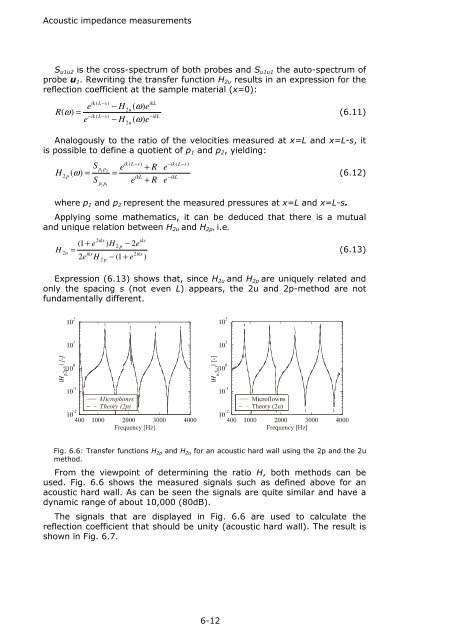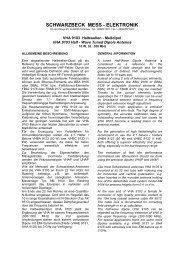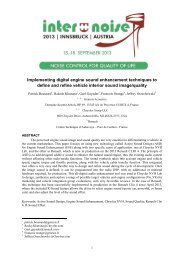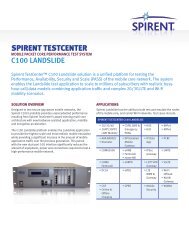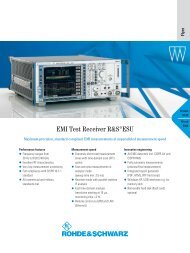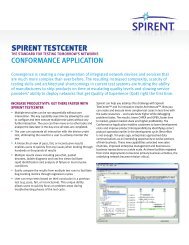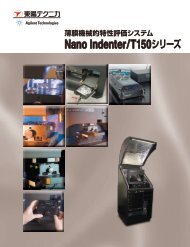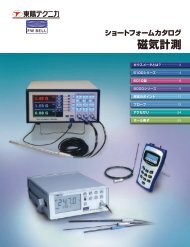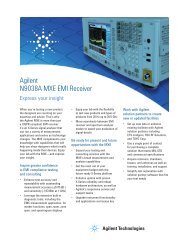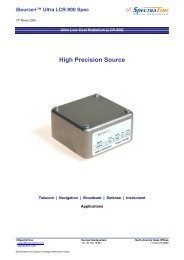Chapter 6: Impedance measurements
Chapter 6: Impedance measurements
Chapter 6: Impedance measurements
You also want an ePaper? Increase the reach of your titles
YUMPU automatically turns print PDFs into web optimized ePapers that Google loves.
Acoustic impedance <strong>measurements</strong><br />
S u1u2 is the cross-spectrum of both probes and S u1u1 the auto-spectrum of<br />
probe u 1 . Rewriting the transfer function H 2u results in an expression for the<br />
reflection coefficient at the sample material (x=0):<br />
ik ( L−s)<br />
ikL<br />
e − H2u<br />
( ω)<br />
e<br />
−ik ( L−s)<br />
−ikL<br />
−<br />
2u<br />
( ω)<br />
R( ω)<br />
=<br />
e H e<br />
(6.11)<br />
Analogously to the ratio of the velocities measured at x=L and x=L-s, it<br />
is possible to define a quotient of p 1 and p 2 , yielding:<br />
H<br />
S e + R e<br />
ik ( L−s) −ik ( L−s)<br />
( )<br />
p1 p2<br />
2<br />
ω = =<br />
−<br />
p ikL ikL<br />
S<br />
p p<br />
e + R e<br />
1 1<br />
(6.12)<br />
where p 1 and p 2 represent the measured pressures at x=L and x=L-s.<br />
Applying some mathematics, it can be deduced that there is a mutual<br />
and unique relation between H 2u and H 2p , i.e.<br />
H<br />
2iks<br />
iks<br />
(1 + e ) H 2 p − 2e<br />
= (6.13)<br />
iks<br />
2<br />
2e<br />
H − (1 + e )<br />
2u<br />
iks<br />
2 p<br />
Expression (6.13) shows that, since H 2u and H 2p are uniquely related and<br />
only the spacing s (not even L) appears, the 2u and 2p-method are not<br />
fundamentally different.<br />
10 2<br />
10 2<br />
10 1<br />
10 1<br />
|H |<br />
10 0<br />
|H |<br />
10 0<br />
10 -1<br />
10 -1<br />
10 -2<br />
10 -2<br />
Fig. 6.6: Transfer functions H 2p and H 2u for an acoustic hard wall using the 2p and the 2u<br />
method.<br />
From the viewpoint of determining the ratio H, both methods can be<br />
used. Fig. 6.6 shows the measured signals such as defined above for an<br />
acoustic hard wall. As can be seen the signals are quite similar and have a<br />
dynamic range of about 10,000 (80dB).<br />
The signals that are displayed in Fig. 6.6 are used to calculate the<br />
reflection coefficient that should be unity (acoustic hard wall). The result is<br />
shown in Fig. 6.7.<br />
6-12


